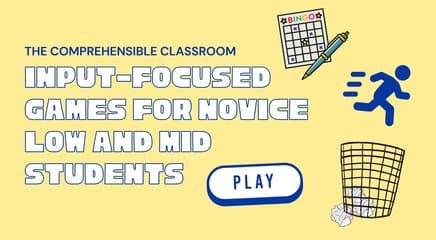Being a comprehensible input teacher demands that students have opportunities to produce output. Read why here.

Once we understand output is not a taboo for a TCI teacher, we can start the search for fun ways to allow students to build productive confidence and competency! "People searches" are one of the fastest, easiest, and lowest-anxiety output activities that you can use in your classes. I like them because they allow students to do a lot of talking in a very short period of time, which means that I am left with lots of class time to focus on comprehensible input.
Here is a quick activity that I use to practice the verb "tener" (to have)--click on the picture to download it. If anyone wants to translate it into another language, please send me your form so that I can post it on the blog for other teachers of your language to use--the editable file is included in the .zip folder downloadable here :)
LESSON PLAN:
- Provide students with lots of comprehensible input! Focus on the structure “tiene”, but make sure to use dialogue to get in repetitions of “tengo” and “tienes”. There are an infinite number of ways to get in repetitions of these target structures through comprehensible input (embedded readings, MovieTalk, storyasking, PQA, etc.), so choose one that works for you, your students, and your curriculum. I use this activity after the unit “Las novias de mi hermano”, and another option would be to use this basic story script and reading.
- Distribute the worksheet to students. Page 4 includes some body parts and other vocabulary, while Page 5 consists entirely of cognates and therefore can be used earlier in the year. You choose!
- Explain the instructions to students. They must fill two rows (horizontal, vertical, or diagonal) with signatures from their classmates. They obtain signatures by pairing up with a classmate and asking ¿Tienes _______________ (read the words in the box)?. The classmate will respond, “Si, tengo _________” or “No.” If he or she says “Sí”, he or she may then sign the box. Then, each student finds a new partner and repeats the process. The same person may NOT sign twice. A good strategy for finding partners is the Kagan “Stand Up, Hand Up, Pair Up” structure. Students stand up, put their hands in the air, high-five someone, and then pair up with that person. When they have completed the task, they put their hands back in the air and find a new partner to high-five and pair up with. To keep kids talking in the target language, I unleash the “Hole Puncher Police”. Read this post for an explanation.
- As the first few students complete the task by filling two rows, have them keep going to try to fill their entire board until many students have completed the two-row task.
- Call students back together.
- Lead a class discussion about the data that students have collected. Use TPRS®/CI strategies like circling, checking for comprehension, and personalization.
- Collect papers. Based on the responses and the class discussion, use them to create a reading that students can work with in class the next day. Here are some more ideas for extending class discussions.




